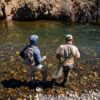
Few individuals are as keenly aware of the changes of season as the angler…and the fall is one of the angler’s most revered seasons. From the subtle changes in air and water temperature which shift hatches back to the middle of the day like a moveable feast, to trout feeding with urgency upon the fall insects as the days grow ever shorter with the approach of winter, the angler bears witness to all these changes with great anticipation. Anglers fishing our waters can expect classic September conditions. Temperatures are going to be bouncing from highs in the 50s to the low 70s over the next week and the morning lows will definitely bring a chill to the air. This cooler air should trigger some terrific Baetis action on all our rivers. Red Quills are gaining strength and Mahogany Duns should follow suit. Also with the cooler temperatures, there will be no need to get up early and the evening fishing will shut down even before the sun drops. All the freestones have low flows and the area tailwaters are dropping to more wadable levels.
Silver Creek
This is a fun time of year to be on the Creek. The browns are getting randy and the crowds are gone. Expect to find short windows of really good dry fly fishing with Baetis and Callibaetis in the late morning between 11 and 2. On cloudy, cooler days the Baetis in size 22 and 24 can really be fantastic. The Callibaetis (size 18) are still present in the middle of the day, especially on the slower stretches. More and more Mahogany Duns are being spotted and should become a good option over the next few weeks. Sometimes the trout really seem to prefer this size 16 bug over the plethora of Baetis on the water. When the wind blows use a hopper, an ant, or a beetle. The wind is always a blessing on the Creek when the hatches are weak. These fish lose all their inhibitions with a chop on the surface and anglers can really capitalize on this using a terrestrial. This is also a good time of year to experiment with nymphing on the Creek. The best method is to use a dry with a nymph dropper suspended above the weeds. Cover a lot of water with this method and try to keep the flies isolated in the channels between the tall weeds. If you can find deeper holding water you might try using a traditional indicator to help suspend a heavier nymph or nymphs. Trouthunter Fluorocarbon tippet in size 5 and 6x really is essential. Fluoro is heavier than nylon and helps get the flies down. For nymphs, try using pheasant tails (with or without beads), Zebra midges, WD40s, Barr’s Emergers, RS2s all in size 16, 18, 20, 24. You might also consider pulling a streamer through some of the gravelly bottom stretches of the Creek to try and entice a territorial brown. We have a great streamer collection from the traditional Woolley Bugger to the multiple One Fly winning Double Bunny. This can be a great method during low light conditions or if you see a very aggressive brown chasing fish around a hole.
Big Wood River
The Wood is one of my favorite fall fisheries. The water is low but the fish are still spread out from the fast shallow riffles to the slow tailouts at the bottom of a run. I like fishing small parachute patterns in size 16 and 18 like a Purple Haze or a Gulper Special. You might run into some flying ants this time of year, so always have a few in your box. If I am going to search water with a single terrestrial, I will often choose an ant over a hopper on this river. The Red Quills are coming on strong as well. Since the water is low, you need to use 6x and a 9 foot or longer leader when fishing the smaller flies. Approach the water with caution and scan the shallow edges and tailouts or you will spook more fish than you catch. When fishing the big bugs, like the Red Quill, a hopper, or an ant you can easily get away with using 5x, but you still need to exercise caution. Nymphing the Wood this time of year can be extremely productive. A simple dry dropper rig is very effective. Trailing a small size 16 or 18 Zebra Midge in red or black, a bead head pheasant tail, Bishop’s Dynamite, or Rainbow Warrior can turn a slow day around. For all the above mentioned nymphs, I prefer tungsten beads to help get them down to the fish.
Big Lost River below Mackay
As Mackay reservoir cools it signals the land locked Sockeye, called Kokanee, to run up the river and spawn. The upper river is full of these red fish and anglers looking to experience a slice of Alaskan style angling can find it here. Look for the rainbows to be lurking in the midst of these spawners. Egg patterns are a good choice and even flesh flies will have their time as the Kokanee begin to die and rot. Below the reservoir the flows continue to drop. As of today, the flows are around 300 and may continue to drop even more over the next few weeks. Check the Idaho River Flows link on our website to see current flows. The Tricos and Baetis are still hatching but the cooler temperatures have moved the bug activity to the late morning and through the middle of the day. When the bugs are gone be prepared to nymph. Of late, the fish are harder to hook, which may be because of the pressure they are under from anglers. The key to success on these fish is contact with your flies. European Nymphing techniques will increase your catch rate dramatically. For bugs, be sure to have Crane Flies, Tricos ( size 22-24), Baetis (size 18-20) and an assortment of nymphs such as King Princes (size 12, 14), San Juan Worms, Flashback Pheasant Tails (size 14, 16), Bishop’s Dynamite (size 14, 16, 18), Zebra Midge (size 16,18) WD40s (size 18,20) and Rainbow Warriors (size 16,18,20).
Upper Big Lost
Many anglers give up on this fishery this time of year, but good fishing can still be found. The best action is happening on the Main Stem of the Upper Lost from the North Fork confluence and down. The river is low and the fish are spread out. You can expect there to be maybe one good fish per run with only one legitimate chance at getting a strike…so make it count. The fishing is best from the middle of the day into the late afternoon. Don’t expect to see too many bugs and be prepared to cover a lot of ground to find fish. The Whitefish are eager to eat a fly and a few quality Rainbows, Cutbows, Brook Trout, and Cutthroat can be found as well. As I said last week, if you are looking for huge numbers of trout, stick to the Wood, but if you want to search gorgeous water for that one fantastic trout, give this a try. Take along an assortment of your favorite attractor dry flies and nymphs as well as your standard parachute patterns: Parachute Hare’s Ear, Turk’s Tarantulas, PMX, Royal Wulffs, King Prince, Flashback PTs and Zebra Midge.
Salmon River
Check with us about road closures in this area due to the fire. The fishing can be good and the smoke has been intermittent with a majority of the smoke blowing to the North. Right now the only part of the river that is accessible is the stretch from Four Acres to the town of Stanley and the fishing has been fair. For flies, I still like Yellow and Orange Stimulators even though the Stones are long gone and attractors such as Turk’s Tarantula as well as Hoppers work great. Also, the Spruce Moth is still taking fish and can provide excellent dry fly fishing. Nymphs, such as Tungsten PTs and Dynamites in size 16 tied of the back of these big bugs will also be good producers.
Warm Springs & Trail Creek
These rivers are low and provide a great alternative for those seeking a small stream experience but don’t have the time to drive over the hill to the Upper Lost. Fish and Game has stocked these rivers around the bridges and anywhere the rivers near the road. If you wish to seek wild fish, just leave the beaten path and explore. Expect to see rusty Spinners, Caddis, Ants, Hoppers, and some Spruce Moths.
South Fork of the Boise
The flows have come down to a very wadable 595 CFS and things are turning the corner on this fantastic tailwater fishery. The flotilla of drift boats are gone and wade fisherman will now rule the waterway. Look for Pinks and Flavs along with fall Baetis to be the main course. Also craneflies will be seen skittering about with a few caddis still lingering in the evenings. If you find no bugs about, you might try a hopper as well. Nymphing is also going to be productive with the usual suspects such as PTs (size 16-20), Zebra Midge (size 18,20), as well as stoneflies and caddis larva imitations. I like nymphing with either a stone or caddis larva as an anchor fly along with a smaller midge or mayfly imitation when nothing else is going on. Fall fishing on this river can truly be spectacular.
Area Reservoirs
It is that time of year when I begin thinking about spending some time on one of our local reservoirs again. Little Camas, Magic, Mackay, or Duck Valley are all going to be fantastic options this time of year. The fish are going to be anywhere from 2 to 4 inches bigger from this spring and just like their brethren in the river they will begin to feed voraciously to fatten up for the onset of winter. So grab some fins and a tube and hold on to your rods…reservoir fish are hot!
Everyone should believe in something. I believe I’ll go fishing.~ Thoreau
photo by Terry Ring




